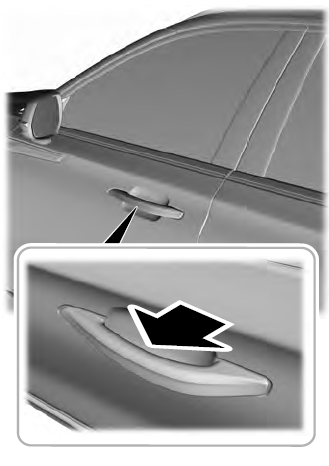Lincoln Aviator: Supplemental Restraint System / Removal and Installation - Clockspring
Removal
.jpg) WARNING:
The following procedure prescribes critical repair steps
required for correct restraint system operation during a crash. Follow
all notes and steps carefully. Failure to follow step instructions may
result in incorrect operation of the restraint system and increases the
risk of serious personal injury or death in a crash.
WARNING:
The following procedure prescribes critical repair steps
required for correct restraint system operation during a crash. Follow
all notes and steps carefully. Failure to follow step instructions may
result in incorrect operation of the restraint system and increases the
risk of serious personal injury or death in a crash.
NOTE: Removal steps in this procedure may contain installation details .
-
Refer to: Pyrotechnic Device Health and Safety Precautions (100-00 General Information, Description and Operation)..jpg) WARNING:
Before beginning any service procedure in this
manual, refer to health and safety warnings in section 100-00 General
Information. Failure to follow this instruction may result in serious
personal injury.
WARNING:
Before beginning any service procedure in this
manual, refer to health and safety warnings in section 100-00 General
Information. Failure to follow this instruction may result in serious
personal injury.
-
Remove the following items:
-
NOTE: Follow the unique instructions or graphic for this step in installation.
Remove the steering wheel.
Refer to: Steering Wheel (211-04 Steering Column, Removal and Installation).
-
Remove the steering column shrouds.
Refer to: Steering Column Shrouds (501-05 Interior Trim and Ornamentation, Removal and Installation).
-
-
-
Disconnect the clockspring electrical connector.
-
Remove the clockspring screws.
-
NOTE: Follow the unique instructions or graphic for this step in installation.
Remove the clockspring.
-
Disconnect the clockspring electrical connector.
.jpg) |
Installation
NOTICE: If installing a new clockspring, do not remove the clockspring anti-rotation key until the steering wheel is installed. If the anti-rotation key has been removed before installing the steering wheel, the clockspring must be centered. Failure to follow this instruction may result in component damage and/or system failure.
-
NOTE: Illustration shows the cancel tab in the off position.
Before installing the clockspring, position the turn signal stalk to the off position.
-
Ensure the turn signal cancel tab is in the off position.
-
Ensure the turn signal cancel tab is in the off position.
.jpg) |
-
To install, reverse the removal procedure.
-
NOTE: This step is only necessary if adjustment or centralizing is required.
Adjust the clockspring.
Refer to: Clockspring Adjustment (501-20 Supplemental Restraint System) .
-
NOTE: Remove the anti-rotation key from a new clockspring after installing the steering wheel.
Install the steering wheel.
Refer to: Steering Wheel (211-04 Steering Column, Removal and Installation).
.jpg) |
 Removal and Installation - C-Pillar Side Impact Sensor
Removal and Installation - C-Pillar Side Impact Sensor
Removal
WARNING:
The following procedure prescribes critical repair steps
required for correct restraint system operation during a crash. Follow
all notes and steps carefully...
Other information:
Lincoln Aviator 2020-2025 Owners Manual: Fuel Quality
Choosing the Right Fuel Your vehicle is designed to operate on regular unleaded gasoline with a minimum pump (R+M)/2 octane rating of 87. Some fuel stations, particularly those in high altitude areas, offer fuels posted as regular unleaded gasoline with an octane rating below 87...
Lincoln Aviator 2020-2025 Service Manual: Removal and Installation - Front Head Restraint
Removal NOTE: This procedure is for vehicles equipped with power head restraint only. NOTE: Drivers seat shown, passenger seat similar. Remove the front seat. Refer to: Front Seat (501-10A Front Seats, Removal and Installation). Remove the front seat backrest panel...
Categories
- Manuals Home
- Lincoln Aviator Owners Manual
- Lincoln Aviator Service Manual
- Changing the Front Wiper Blades - Vehicles With: Heated Wiper Blades
- Locking and Unlocking
- Fuel Quality
- New on site
- Most important about car
Activating Intelligent Access
The intelligent access key must be within 3 ft (1 m) of the door or luggage compartment you intend to lock or unlock.
At a Door
Electronic door handles are on each door. Gently depress the switch inside the exterior door handle to unlock and open the door. An unlock symbol illuminates on the door window trim indicating your vehicle is unlocked.


